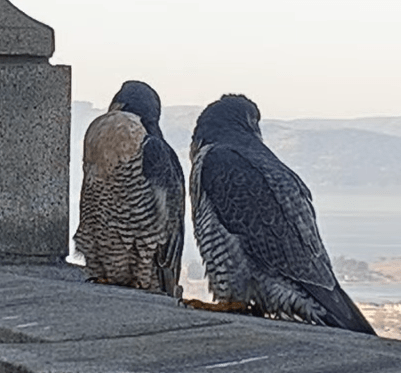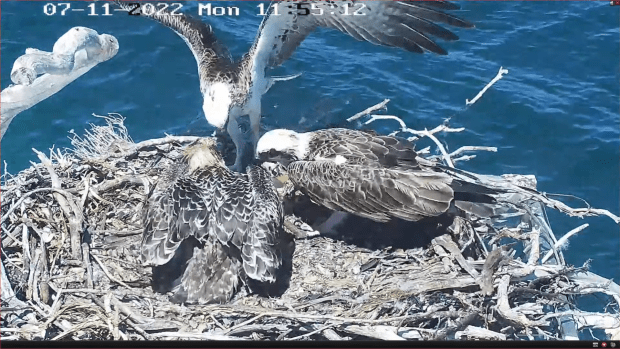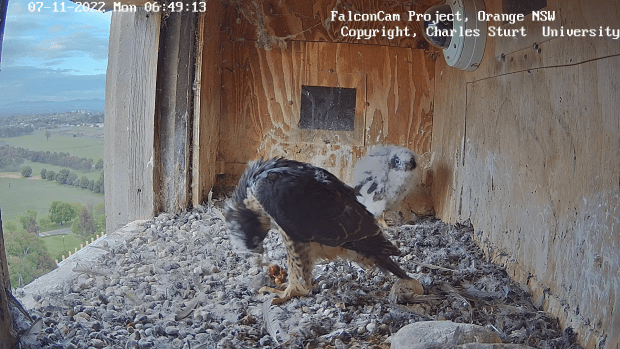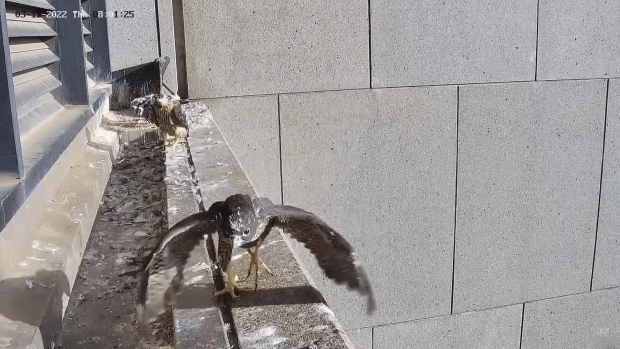23 November 2022
Good Morning Everyone!
I hope that you are well. Tomorrow is Thanksgiving in the United States. In Canada, we have already had our harvest festival in October but, as one of the readers reminded me, it is a time to give thanks for all of those in our lives — so to all of you wherever you may be, ‘thank you for being part of this great community’. Your empathy, caring, understanding, and joy are remarkable and this year we have been so much together. And to all of our feathered friends, thank you for the joy and the tears and for reminding us that we are all in this world together, not separate.
Dyson sends greetings from all of us to all of you. She hopes that you have plenty of ‘nuts’ for your celebration while reminding all of us to share with the wildlife.

There is simply not a lot going on in Bird World. Only one thing seems to be on anyone’s mind now that Zoe has fledged. When will Rubus fly up to the scrape? Rubus has flown. Shines reports that Rubus was on the ground and observed to fly 200 m to his perch. Indigo has been up in the scrape box and so have the adults. And he flew some more later and picked up a prey delivery (see below). Life feels good right now. All are well.
Interesting to note that Xavier was in the scrape box ‘scraping’ – is he already thinking about next year? A scrape is a shallow indentation in the gravel or sand in which the eggs are laid.


It is extremely heart warming to know that all of the staff at Charles Sturt University keep an eye out for the falcons. Rubus was found on the ridge of the Printery Roof. Here is a video showing a prey delivery for Rubus from Xavier. So, we can all relax. Xavier and Diamond are taking good care of both Indigo and Rubus and there are all kinds of caring eyes looking out for them!
Thanks ‘A’ for sending me the link to the video and this comforting news!
If you missed Zoe’s fledge, here is my short video clip. She was really working her wings earlier and her first flight took her right down to Dad’s shed. Perhaps Ervie will come and join them for a good old ‘chin wag’. Zoe is 66 days old.
Mum is in the nest and Dad is on the ropes. Zoe is still down in the shed. She will figure out how to fly back up to the nest. If I recall, this is what Bazza did last year! Please correct me if I am wrong.

There should be no worries. Zoe flew up to the nest at 1451 and booted Mum off. She is now prey-calling and I presume that one of the adults will be out to get their girl a nice fish for her accomplishment!

Zoe later flew back and forth to the perch and around the barge. It appears from all the time tables that Zoe did not get a fish after fledgling. Thanks to ‘A’, here are the major events from the observation board for Port Lincoln for the day: Fish count: Dad: 2, Mum: 0 Fish times: 08:37, 11:49 08:37 dad with headless fish, mum takes it away 08:46 mum returns, Zoe self feeds 9:00:56 Zoe eats the tail.
10:54:45 Zoe fledges from the nest and ends up in the mancave Facebook post on fledge
11:49:45 Fish tail end by Dad. Zoe was in the mancave 11:55 Mum eats the tail. 14:51:55 Zoe returns to the nest, where mum was, who then leaves
18:40 Zoe from nest to close perch (and back and to the perch) and flying around the barge
‘H’ made a video clip that shows Zoe’s fledge and her subsequent flights which are not included in mine. Thanks so much ‘H’.
————————————————————————————-
Making News:
Dave Hancock of Hancock Wildlife is building shaded nests for the eagles to help them with the increasingly number of heat domes that are part of climate change in British Columbia. Here is an image of one of those nests with the Delta 2 Eagles.

The British Trust for Ornithology is watching with great concern as the migrant birds from parts of Europe arrive in the UK for their winter holidays.


BirdLife’s 2022 Photography Awards are in and there are some stunning images.
There are many categories and many birds that will be familiar that are in those winning shots including the Albatross, BooBook Owl, Wood Ducks, Petrels, Wrens, and Lyrebirds. Enjoy!
What you might not know is that you do not have to be Australian to enter. Maybe think about submitting some of your images next year. One section of the Birdlife website that fascinated me was the ‘tips and tricks’ to getting bird photos. Mine would never win any awards but I would love to be able to take better photos of our beautiful feathered friends. To check out on the regulations for the annual awards and to see the tips and tricks, please go to:
birdlifephotoaward.org.au
————————————————————————————
In Senegal, Jean-marie Dupart reports that he counted 331 Ospreys in a stretch of beach measuring 143 km. That is fantastic news!
———————————————————————————–
In the United States, the Osprey breeding season starts after the Bald Eagles. Jack and Diane at the Achieva Osprey nest in St Petersburg, Florida have been visiting their nest. I wonder if they even know where to start with all the weeds that have grown up!

I keep heading over to the West End nest of Thunder and Akecheta to see if I can catch them at the nest but, no luck today!

I didn’t find anyone at home at Fraser Point either and they are playing highlights on the Two Harbours cam.

Harriet and M15 have been on and off the nest today. Many thought that today might be the time for the first egg’s arrival but, it doesn’t appear to be the case. Perhaps tomorrow!

Gabby is looking particularly gorgeous these days. She is keeping her eyes out for any intruders near the nest she shares with Samson at Jacksonville, Florida.

————————————————————————————-
No 12. The Red List: Ring Ouzel

“Alpine Ring Ouzel (Turdus torquatus), Karwendel mountains, Austria” by Frank.Vassen is licensed under CC BY 2.0.
In his description of this beautiful Blackbird with its white half moon torque on the male, Nick Baker says, “It’s the thinking person’s Blackbird, the connoisseur’s choice; a passerine, that keeps itself to itself and is somewhat exclusive, hiding away from the cheap (ing) twittering masses of other perching birds, other than the odd curved, Wheatear and pipit.”

“Ring Ouzel male” by Rainbirder is licensed under CC BY-NC-SA 2.0.
Baker likes the stunning black birds because they are elusive one has to “invest some kind of effort to find one makes them all the more appealing…” Baker lives in Dartmoor, where a small population of these passerines “hangs on.” He says “the situation is about as delicate as the frosted feather edges on the bird’s breast.”
This lovely print shows the adults and the wee one. Notice the silvery wing panels on both the male and the female. You can see them easily in the photograph by Rainbirder above, also. The male’s crescent moon is pure white while the female’s is ivory barred with a rust brown. Instead of a black chin, the female has vertical barring, dark chocolate on white. Once again, I think that the female is just as stunningly beautiful as the male – her head, back and tail are not the pure deeply saturated black. In fact there is more variety to her plumage. The spots on the chest of the juvenile with its brown head, back and wings remind me of the work of Denmark’s most accomplished ceramic artists, Priscilla Mouritzen.

“Ring Ouzel (male left female above young right)” by Wildreturn is licensed under CC BY 2.0.
The ring ouzel is a member of the thrush family. It grows to approximately 24 cm or 18 inches in length. They are smaller than Blackbirds but are often misidentified as being a Blackbird unless you see that stunning half moon panel.
They breed in the drags and gullies of the steep valleys from mid-April through to mid-July normally having two clutches. Their nests are located close to the ground in dense heather or in a crevice. It would be very rate to see them nest in a tree. They feed their young earthworms and beetles and as adults they eat insects and berries.
The threats that these birds face are quite numerous. The predation of eggs is a start because of nesting close to the ground. They are disturbed by humans, their habitat has been destroyed due to deforestation in the areas where they winter in Spain and in Africa. Climate change has had a significant impact on the bird. The authors of the book noted below, possibly the very best study of these birds, notes that the landscape of the North York Moors might become completely unsuitable for them in the future.
One of the best books on this species is this volume, The Ring Ouzel. A New from the North York Moors. The retired duo hiked, observed, and gained considerable knowledge which they have passed on to us in a delightful little book. I keep thinking how wonderful they were to find this specific place now and provide us with insights into a bird that is most elusive.

————————————————————————————-
Migration News:
I am still following two of the four fledglings from Karl II’s Black Stork family from the Karula National Forest in Estonia. Those two are Waba and the foster chick, Bonus. The only surviving strolling from the last brood of Jan and Janikka.
Bonus remains in the area of Turkey (Konya Province) where he has been for what seems like forever. It is an area that can get cold in the winter with snow and everyone is hoping that he will decide to get moving!


Waba remains in the Sudan feeding on the Nile River. He travelled 242 km in the last few days (his tracker was not transmitting for some of that time).


Both of the Black Stork juveniles seem to have found water and lots of food and it appears that each is reluctant to leave their respective locations. It is always a relief to know that they are well but, like everyone else, I hope that Bonus will get an itch to fly and that he will head south to catch up with the remainder of his family in Africa.
Thank you so very much for being with me today. We will be keeping an eye on Zoe as she perfects her flying skills along with dear Rubus and Indigo at Orange. Take care everyone. See you soon!
Thank you to the following for their posts, videos, and streaming cams where I took my screen captures: ‘A’ and ‘H’ as always – so grateful, Charles Sturt Falcon Cam and Cilla Kinross and gang, Port Lincoln Ospreys, British Trust for Ornithology, ave Hancock and Hancock Wildlife, The Guardian, Achieva Ospreys with Jack and Diane, IWS, SWFlorida Bald Eagles and D Pritchett, NEFL-AEF, Openverse, and Looduskalender Forum.






































































































































































































































